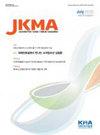Current status and treatment of obesity in Korea
IF 0.5
Q3 MEDICINE, GENERAL & INTERNAL
引用次数: 1
Abstract
Background: Over the last decade, the male obesity rate in Korea has surged from 36.3% in 2012 to 46.3% in 2021. The proportion of overweight and obese students among elementary, middle, and high school students increased from 22.9% in 2016 to 30.8% in 2021.Current Concepts: Various methods, such as body mass index, waist circumference measurement, and impedance body fat analysis, are used to diagnose obesity. Obesity treatment is needed to establish an individualized treatment plan based on the cause of obesity, and behavioral changes should be induced through dietary therapy and exercise. Drug therapy should be considered in patients who could not lose weight despite non-pharmacological therapies for over 3 months and have one or more cardiovascular risk factors. Behavioral therapy is the core of obesity treatment because of its application as a programmed treatment for weight control and an approach to changing behaviors related to food intake and physical activity. If non-drug treatment does not lead to weight loss, drug therapy should be considered. Along with drug treatment, dietary therapy, exercise, and behavioral therapy are essential. In severely obese patients, surgical intervention can be considered for weight loss, the maintenance of reduced weight, and improvement of obesity-related comorbidities, including type 2 diabetes.Discussion and Conclusion: To successfully treat obesity, a combination of dietary plans, exercise programs, and drug therapy are required according to an accurate assessment of the cause and degree of obesity.韩国肥胖的现状和治疗
背景:韩国男性肥胖率从2012年的36.3%上升到2021年的46.3%。超重和肥胖学生在小学、初中和高中学生中的比例从2016年的22.9%上升到2021年的30.8%。目前的概念:各种方法,如身体质量指数,腰围测量,阻抗体脂分析,被用来诊断肥胖。肥胖治疗需要根据肥胖的原因制定个性化的治疗方案,并通过饮食治疗和运动诱导行为改变。非药物治疗超过3个月仍不能减轻体重且有一种或多种心血管危险因素的患者应考虑药物治疗。行为疗法是肥胖治疗的核心,因为它是一种控制体重的程序化治疗,也是一种改变与食物摄入和身体活动相关的行为的方法。如果非药物治疗不能减轻体重,则应考虑药物治疗。除了药物治疗外,饮食治疗、运动和行为治疗也是必不可少的。对于严重肥胖患者,可以考虑进行手术干预,以减轻体重,维持已减轻的体重,并改善肥胖相关的合并症,包括2型糖尿病。讨论与结论:要成功治疗肥胖,需要根据对肥胖的原因和程度的准确评估,结合饮食计划、运动计划和药物治疗。
本文章由计算机程序翻译,如有差异,请以英文原文为准。
求助全文
约1分钟内获得全文
求助全文
来源期刊

Journal of The Korean Medical Association
Medicine-General Medicine
CiteScore
0.50
自引率
0.00%
发文量
84
审稿时长
4-8 weeks
期刊介绍:
The Journal of the Korean Medical Association (JKMA) is the official peer-reviewed, open-access, monthly journal of the Korean Medical Association (KMA). It contains articles in Korean or English. Its abbreviated title is ''J Korean Med Assoc''. The aims of the Journal include contributing to the treatment of and preventing diseases of public health importance and to improvement of health and quality of life through sharing the state-of the-art scientific information on medicine by the members of KMA and other national and international societies.
 求助内容:
求助内容: 应助结果提醒方式:
应助结果提醒方式:


